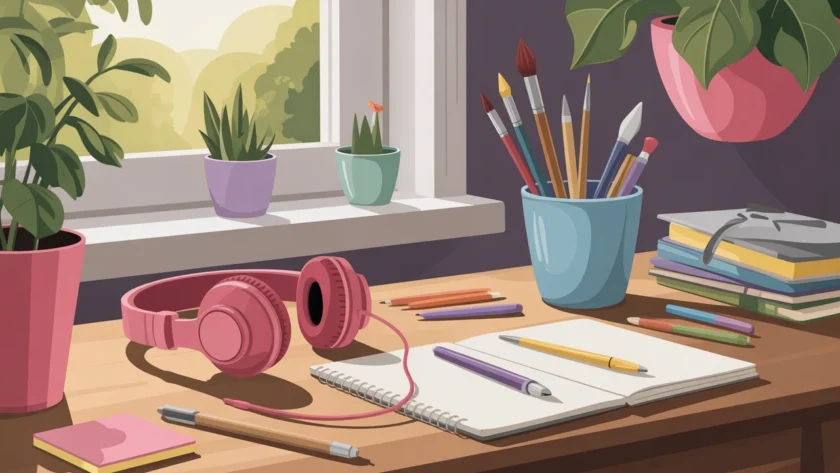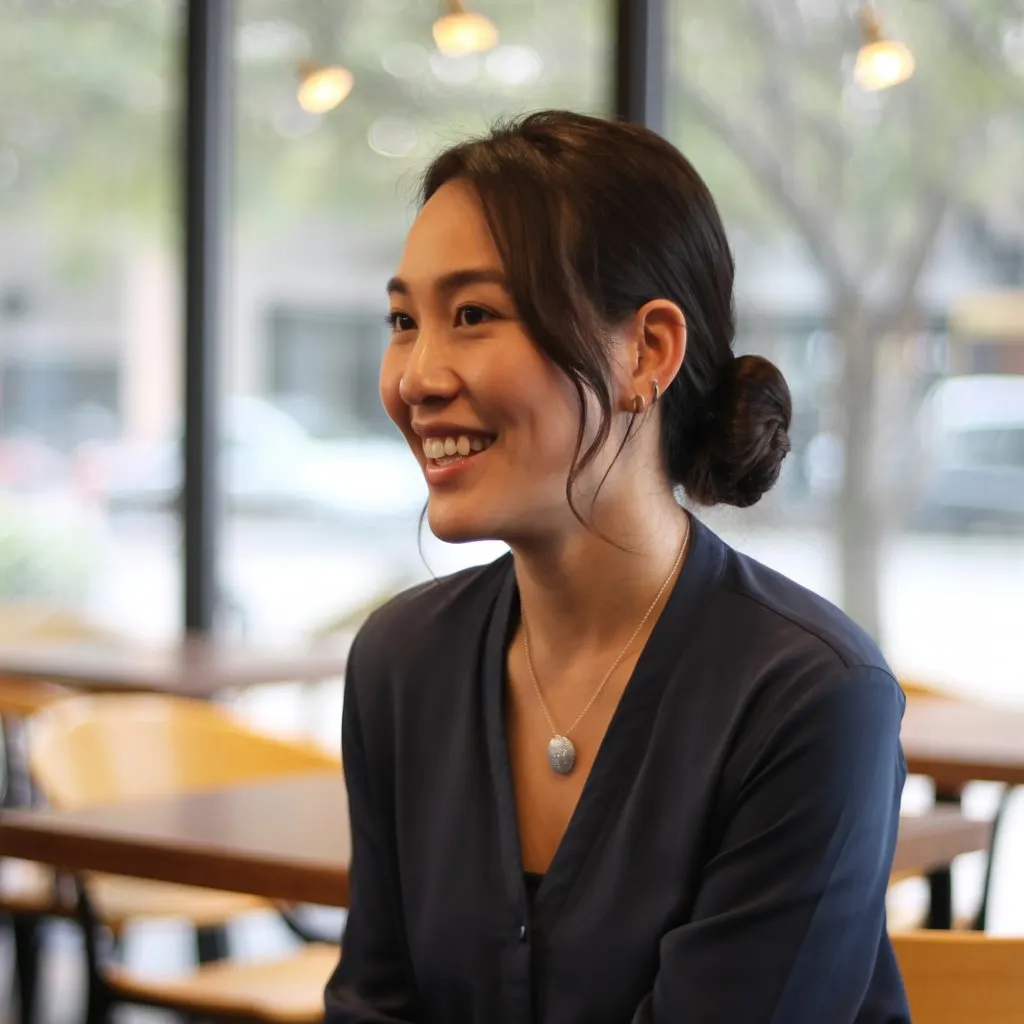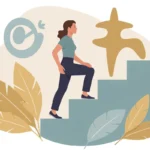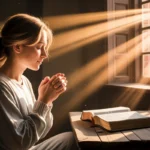I’ll never forget the afternoon I sat on my bedroom floor, surrounded by cheap watercolors and a blank canvas, thinking “This is ridiculous. I’m 32 years old and I can’t even paint a tree.” My hands were shaking—partly from the anxiety that had been my constant companion for months, partly from the vulnerability of trying something completely new. But something happened in those messy brushstrokes. For the first time in weeks, my mind quieted. The anxious thoughts that usually screamed for attention became background whispers.
That afternoon changed how I understood anxiety management. Sure, prayer and therapy were helping, but I’d stumbled onto something powerful: creative expression as a pathway to peace. And friends, if you’re reading this because anxiety has you in its grip, I want you to know that you don’t need to be “artistic” to benefit from creativity. You just need to be willing to try.
Why Creative Expression Eases Anxious Minds
Here’s what I’ve come to understand through both personal experience and conversations with my Christian counselor: when we’re anxious, our minds get stuck in loops. We ruminate, catastrophize, and replay worst-case scenarios until we’re exhausted. Creativity interrupts those loops in a way that few other activities can.
Think about it—when you’re focused on mixing paint colors, finding the right chord progression, or searching for words to describe a feeling, your mind shifts from abstract worry to concrete action. You move from “what if” thinking to “what now” doing. There’s something almost sacred about that shift. It reminds me of how God created—speaking things into existence, forming beauty from chaos. When we create, even in small ways, we participate in that divine nature.
The science backs this up too. Creative activities engage different parts of our brain than the ones responsible for anxious thinking. They activate our prefrontal cortex—the part that helps us problem-solve and find perspective—while quieting the amygdala, where fear responses originate. But beyond the neuroscience, there’s a spiritual component that’s equally important. Psalm 139 tells us we’re “fearfully and wonderfully made,” created in God’s image. That means creativity isn’t just for “artists”—it’s woven into our DNA.
Art as Therapy: Painting Your Prayers
I started with watercolors because they seemed forgiving—if you mess up, you just add more water, right? What I discovered was that painting became a form of prayer I didn’t know I needed. When words failed me, when I couldn’t articulate the knot of worry in my chest, I could express it through color and shape.
You don’t need expensive supplies or natural talent. I’m talking about grabbing a set of colored pencils and a sketchbook from the dollar store. Let me share what worked for me, and what I’ve seen work for others struggling with anxiety.
Start with abstract expression. Don’t try to paint anything recognizable at first. Choose colors that reflect how you’re feeling. Anxious? Maybe sharp reds and chaotic black lines. Seeking peace? Soft blues and gentle curves. There’s something profoundly healing about externalizing internal chaos. It’s like taking the anxious thoughts swirling in your mind and giving them physical form on paper—and once they’re outside of you, they lose some of their power.
I remember one particularly difficult evening when panic attacks had been visiting me regularly. I couldn’t pray coherently, couldn’t sit still, couldn’t even think straight. So I painted. Bold, aggressive strokes of dark purple and gray. And then, as I began to pray wordlessly while painting, I added touches of gold. Not because I felt hope, but because I wanted to remind myself that God’s light penetrates even the darkest anxiety. That painting still hangs in my home office—not because it’s beautiful in any traditional sense, but because it tells a story of a night I survived.
Try meditative coloring. Yes, adult coloring books became trendy a few years ago, but there’s a reason they resonated with so many people. The repetitive motion of staying within lines, choosing colors, and seeing gradual progress creates a meditative state. For those of us whose minds race with anxious thoughts, this kind of structured creativity provides just enough focus to calm our nervous systems without overwhelming us.
I keep a coloring book and colored pencils by my favorite chair. On evenings when anxiety starts building, I’ll spend 20 minutes coloring while listening to worship music. It’s become a ritual that signals to my body: “We’re safe. We’re slowing down. God’s got this.”
Music: Composing Peace in the Midst of Chaos
Now, I’m going to be honest—I can’t carry a tune to save my life. Bailey, my rescue dog, actually leaves the room when I sing. But music for anxiety relief isn’t about performance; it’s about participation and expression.
Playing an instrument engages your whole being. Your mind focuses on reading notes or finding the right keys. Your body coordinates movements. Your emotions flow through the sounds you create. This complete engagement is exactly what anxious minds need—a compelling reason to be fully present in the moment rather than catastrophizing about the future.
A friend from my church started learning piano at 45 specifically to cope with her anxiety disorder. She told me something I’ll never forget: “When my fingers are on those keys, I can’t be anywhere else. I can’t be in tomorrow’s worries or yesterday’s regrets. I have to be right here, right now.” That’s the gift of musical expression.
You don’t need to invest in expensive instruments or lessons. Here’s what I’ve found works:
Start simple with rhythm instruments. A hand drum, tambourine, or even just tapping rhythms on your lap can be incredibly grounding. There’s research showing that rhythmic drumming can lower cortisol levels—our body’s primary stress hormone. But beyond the science, there’s something primal and spiritual about rhythm. Think about how many Psalms reference making music with drums and cymbals. David understood that worship through rhythm connects us to God in ways words sometimes can’t.
Use your voice, even if you think you can’t sing. Humming, chanting, or singing along to worship music activates the vagus nerve, which helps regulate our stress response. I’ve started a practice of singing hymns while doing mundane tasks. Not performance-quality singing—just my off-key voice praising God while washing dishes or folding laundry. Something about declaring “It Is Well With My Soul” when my soul feels anything but well becomes a statement of faith that anxiety can’t shake.
Create playlists for different emotional states. This might seem simple, but curating music has become one of my most effective anxiety management tools. I have a playlist for when I’m spiraling into panic, full of slow, calming instrumental worship music. I have another for when I need energy and hope—upbeat declarations of God’s faithfulness. The act of choosing songs and organizing them becomes a creative outlet itself, and having them ready when anxiety strikes means I don’t have to make decisions when my mind is already overwhelmed.
Writing: Journaling Your Journey to Peace
If there’s one creative practice that transformed my relationship with anxiety, it’s writing. Not fancy literary writing—I’m talking about honest, messy, sometimes rambling words on paper that nobody else ever has to see.
Morning pages changed everything for me. This practice involves writing three pages longhand every morning before you’ve really woken up, before your internal editor kicks in. You write whatever comes to mind—worries, dreams, to-do lists, prayers, complaints, gratitude. The goal isn’t beautiful prose; it’s clearing mental clutter before it accumulates into anxiety.
I started this practice three years ago during a particularly anxious season. What I discovered was that so many of my worries, when written down, lost their grip on me. The catastrophic scenarios that felt overwhelming in my mind looked almost silly on paper. And the practice gave me a record of God’s faithfulness—I could flip back through pages and see prayers answered, fears that never materialized, and growth I hadn’t noticed in the moment.
Try anxiety-specific journaling prompts. When general writing feels too open-ended, specific prompts can help channel creative expression toward anxiety relief:
- “Right now, my anxiety feels like…” (then describe it metaphorically—a storm, a weight, a noise)
- “If my worried thoughts were a person, I would tell them…”
- “Three things I can control in this situation are…”
- “God, what I need you to know about how I’m feeling is…”
These prompts engage your creative mind while directing your focus toward processing anxiety rather than amplifying it. I keep a list of prompts in my journal for days when I’m too anxious to think of what to write.
Explore poetry as prayer. Here’s what nobody told me about poetry: it doesn’t have to rhyme, follow rules, or make perfect sense. Poetry can simply be a creative way to express what you’re feeling to God. Some of my most powerful prayers have been written as short, free-verse poems—honest cries for help arranged in a way that felt true to my heart.
There’s biblical precedent for this. The Psalms are essentially poetry—raw, emotional, creative expressions of fear, doubt, praise, and trust. David didn’t always write pretty, comfortable words. Some Psalms are desperate pleas filled with anxiety. Yet they’re considered holy scripture because God honors our honest creative expression.
Combining Creativity with Faith Practices
What I’ve learned over the years is that creative outlets work even better for anxiety relief when we intentionally combine them with spiritual practices. This isn’t about adding religious obligation to creative time—it’s about inviting God into the process.
Pray before you create. I started doing this after realizing that my most healing creative sessions happened when I began with a simple prayer: “God, quiet my anxious thoughts. Help me express what I can’t articulate. Meet me here.” Sometimes that prayer is all I can manage, and that’s okay. The invitation is what matters.
Use scripture as creative inspiration. Take a verse that speaks to anxiety—like Philippians 4:6-7 or Isaiah 41:10—and use it as the foundation for creative work. Paint your interpretation of “perfect peace.” Write a story exploring what it means to “cast all your anxiety on Him.” Compose a melody for Psalm 23. This practice roots your creativity in truth while giving anxious thoughts less space to dominate.
Create with gratitude. One practice that’s been transformative for me is combining creativity with gratitude lists. I’ll write in my journal while consciously listing things I’m grateful for, or I’ll paint while thanking God for specific blessings. Gratitude is scientifically proven to reduce anxiety, and when we express it creatively, it becomes even more powerful. It shifts our focus from what we fear to what we’ve been given.
Making Creativity Sustainable (Not Another Pressure)
Now, here’s something important I need to address. If you’re anything like me, your anxious mind might already be turning this into another thing to worry about: “Am I doing it right? What if I’m not creative enough? What if this doesn’t work for me?”
Let me stop you right there with some hard-won wisdom: creative outlets for anxiety relief work precisely because they’re not another performance to stress about. They’re the opposite—they’re spaces where you can be messy, imperfect, and human.
Start ridiculously small. Don’t commit to painting for an hour every day or writing a novel or learning piano in six months. Pick one tiny creative act. Color one page. Write one paragraph. Hum one song. The pressure to be consistent and disciplined can itself become a source of anxiety. Give yourself permission to explore without expectations.
Let it be bad. This might be the most important thing I can tell you. Your paintings can be ugly. Your music can sound terrible. Your writing can be grammatically incorrect and nonsensical. The anxious perfectionist in you will hate this, but healing happens in the mess, not in the masterpiece. I have journals filled with terrible poetry and sketchbooks full of laughable drawings, and they’ve done more for my mental health than any perfect creation ever could.
Find your creative rhythm. Some people need daily creative time. Others benefit from occasional intensive sessions. I’ve learned that my sweet spot is 20 minutes in the morning with my journal and occasional longer painting sessions when I feel anxious energy building. Pay attention to what actually reduces your anxiety rather than what you think “should” work.
Creative Community and Anxiety Relief
While solo creative time is valuable, there’s something powerful about creating with others who understand anxiety struggles. After I’d been painting alone for about a year, I joined a small group at my church that met monthly for “Creative Prayer Nights.” We’d gather with various art supplies, play worship music, and create together while sharing prayer requests.
Those evenings taught me that creativity doesn’t just help us process our own anxiety—it helps us connect with others in authentic ways. When we create side-by-side, something happens. Walls come down. Conversations flow. We stop performing and start being real with each other.
If you can find or form a creative group focused on faith and mental wellness, I can’t recommend it highly enough. Even if it’s just two or three friends meeting once a month to journal together or paint while sharing struggles, that combination of creativity, community, and faith creates a powerful antidote to anxiety’s isolating effects.
When Creative Outlets Aren’t Enough
I need to be honest about something. Creative expression has been profoundly helpful for managing my anxiety, but it’s never been the only tool I’ve needed. I still see a therapist. I still take medication when necessary. I still have days when painting or writing doesn’t quite cut through the panic.
Creative outlets are part of a comprehensive approach to anxiety management, not a replacement for professional help. If your anxiety is severe, persistent, or interfering with daily life, please reach out to a mental health professional. There’s no shame in needing more support than creativity alone can provide. God works through therapists and medication just as surely as He works through prayer and creative expression.
Think of creativity as one instrument in an orchestra of anxiety management strategies. It plays a vital role, but it works best alongside other instruments—professional treatment, spiritual practices, healthy lifestyle choices, and supportive relationships.
Your Invitation to Create
As I wrap up, I’m sitting in my living room where that first messy watercolor painting hangs. It reminds me of how far I’ve come and how creativity became a lifeline when anxiety threatened to pull me under. But more than that, it reminds me that God meets us in the creative process.
You were made in the image of a creative God. That’s not a metaphor or a nice religious saying—it’s a fundamental truth about who you are. And when anxiety tries to convince you that you’re broken, that you’ll never find peace, that worry is your permanent condition, creativity offers a different narrative. It whispers that you can make something new, express something true, and participate in the redemptive work God is always doing.
So here’s my invitation to you: try something creative this week. Not to become an artist or musician or writer—just to give your anxious mind a different channel. Paint something ugly. Write something honest. Hum something hopeful. And as you do, invite God into that creative space. Ask Him to meet you there, to quiet your thoughts, to remind you that you’re more than your anxiety.
Your creative expression doesn’t have to be profound or beautiful or shareable. It just has to be yours—an honest offering from a struggling heart to a loving God who meets us exactly where we are.
Start today. Start small. Start messy. Just start.
And remember: even on your most anxious days, you carry within you the image of a creative God who spoke light into darkness and called it good. Your creative attempts, however imperfect, echo that divine work. And in those moments of creation, you might just find the peace you’ve been searching for.Retry




